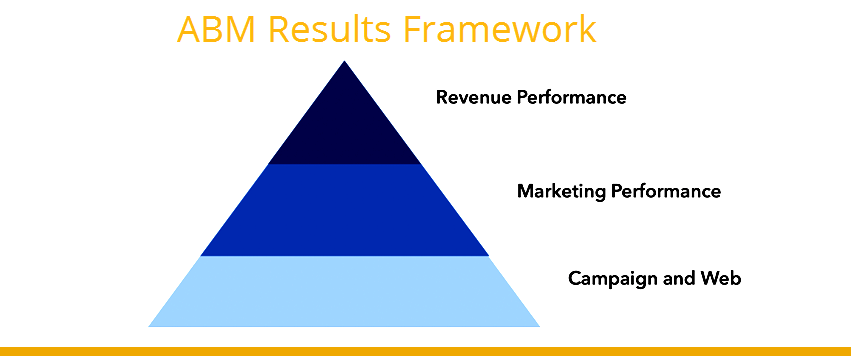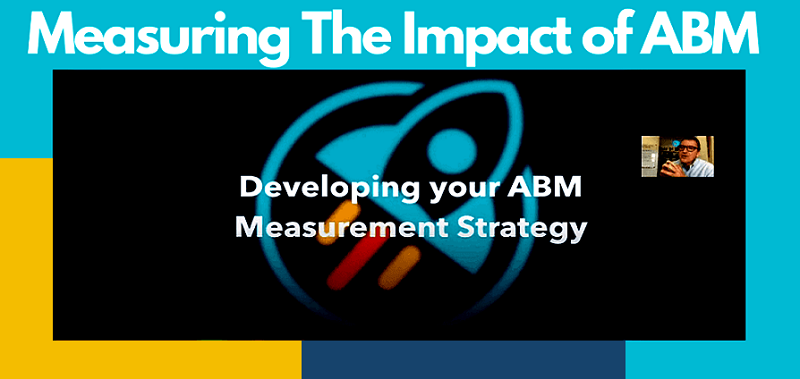How do you go about measuring the impact of ABM? Tracking and measuring ROI remains the leading challenge for Account-based marketing practitioners. This post will guide you on the 3 main ABM measurement criteria, identifying the key ABM KPIs, and the process of tracking and measuring ABM Results
Part of the challenge is linked to a large amount of information and data that is involved. We can’t see the forest for the trees!
ABM Measurement Framework

This is ABM measuring framework from Demandbase, which focuses on measuring performance in 3 different levels.
At the top of the pyramid is Revenue performance measurement.
The second level is Marketing Performance measurement and how it connects to the revenue performance.
At the bottom level are all the different Marketing Campaigns and Web performance measurements
The framework can help you create a Key Performance Indicators (ABM KPIs) dashboard.
Let’s explore the various ABM KPIs under the 3 performance levels
1. ABM KPIs For Revenue Performance

These are the key strategic measures for ABM. If you have a good handle on these three KPIs, you will be better able to forecast revenues.
1.1 Deal Close Rates
What percentage of deals close, i.e. your hit rate. I like to measure the ratio from qualified opportunity to deal close.
1.2 Average Deal Size
In my own business, we paid a lot of attention to this as it was the main growth driver. Given how long sales cycles rea in healthcare, you may be more successful in making an impact on this KPI than others.
1.3 Funnel Velocity Impact on ABM
This may be the single most important metric. In the words of my friend and colleague, Matt Pickens:
To get someplace on time you need to know how fast you are traveling. To hit a sales goal, you need to know how fast you are selling (and how fast your buyers are buying). Speed of selling is also known as Sales Velocity and it is among the most useful and least understood sales metrics. For any B2B organization looking to achieve greater results, Sales Velocity offers a simple yet powerful framework to accelerate performance.
2. ABM Marketing KPIs

Under ABM marketing performance, there is a wide range of ABM KPIs to measure based on what fits your goals and strategy best. These ladder up to sales performance so select the Marketing Performance KPIs that help you measure Sales Performance Indicators.
However, it’s important to note that the measurements or performance results should be with respect to your target accounts.
Some of the ABM Marketing KPIs, or performance metrics to focus on during your measuring process include:
2.1. Target Account List (TAL) Engagement
This involves assessing the extent to which the companies in your target account list engage with your company.
The more the engagement or the frequency of engagement, the higher the marketing performance impact
2.2. Pipeline – % of Sales Accounted For By Your TAL
You need to evaluate the overall percentage of the pipeline sales that are directly linked to your Target Account List.
This ABM measurement, therefore, will help you in evaluating if your current TAL is effective for your marketing campaigns.
2.3. TAL Website Engagement Level
This requires you to analyze how many of your Target Account List are actively engaged in your websites. This may include a wide range of metrics such as what they are searching for, the links they click, and how long they take on pages. It also includes how often they return, among others.
2.4. Total Conversion Rate
While the level of website engagement is critical, the other key measurable marketing metric is your TAL’s conversion rate. The higher the conversion rate, the higher your ABM marketing performance.
2.5. Influence As an Alternative To Attribution
Attribution is basically trying to understand a combination of unique events that can influence your target accounts to take action.
But then, measuring attribution is very difficult and often inaccurate. Influence may be a better alternative. You can develop influence measures by shifting your analysis to look at engagement in your content and social media channels.
2.6. Customer Retention & Upsell
To what extent is your ABM strategy influencing your current customers to upgrade their current systems, or to purchase a more expensive solution?
2.7. Cost Per Opportunity
Basically, it measures the cost of getting a new customer. Duh! 🙂
3. ABM Campaign and Web Measures
We often just focus on basic metrics like users per month, page views, downloads, etc. In fact, these are the building blocks and they are how you get to Marketing Performance measures.
They are the tools you will use to create strategically valuable marketing performance measures. Examples of these measures:
- Cost Per Lead
- Conversion Rate
- Purchase Funnel
- Incremental sales among others.
Web performance includes but not limited to the following:
- Total web visits from your target account lists,
- bounce rate
- the average time a target customer takes on a page
- A number of new visitors
- Many others.
How To Evolve Your ABM Measurement Model

Having discussed the various levels of ABM results measurements, here are the 3 phases you can use to smoothly evolve your measurement models:
1. Short-term ABM Success Measurement
These include some of the key measurement areas that you need to focus on in the first six months. As your ABM program continues to grow, you can evolve your ABM results measuring model accordingly.
So, at this early phase stage, your measurement models ought to focus on the following:
- Conversion Rates
- Target Account Engagement
- Account Penetration
- Influence
2. Mid-Term ABM Measurement
So, as your ABM program evolves and begins to expand, it’s time to upgrade your ABM results measuring models. In the mid-term, consider measuring the following ABM performance indicators:
- Pipeline
- Cost Per Opportunity
- % Of Opportunities From Target Account List
3. Long-Term ABM Results
The goal is to get to a reliable measure of revenue performance because this is THE indicator of your ABM success. Hopefull within 6-9 months you will have the following KPIs working:
- Close Rates
- Average Deal Value
- Funnel Velocity
- Revenue
It’s important that you start small, by focusing on measuring the key short-term performance results, then work your way up, and include other metrics as your ABM program continues to expand.
If you want help with your account-based marketing strategy for healthcare, contact us.

